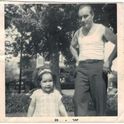We're making a chocolate cake - what's the best ratio of leavening to flour to avoid lumpiness and promote smooth, even layers?
We started with a chocolate cake recipe we loved that calls for 1/4 teaspoon of leavening per cup of flour; we wanted something less dense and higher-rising. Shirley Corriher recommends 1 1/8 teaspoons of leavening, but that seems like too much - we're ending up with layers that have high and low spots even though we're using a collar to promote even baking. Is there a better ratio of levening to flour? Is it something else? Or are we destined to be leveling with dental floss?
21 Comments
Thanks again for the doneness-checking tip, ChefDaddy. It was very helpful.
*First: yesterday I was assuming that the butter I left out on the counter would be close to room temperature, so I never actually stuck my thermometer in the butter to check. I just realized that in the middle of the day yesterday, I ran my dishwasher to clean up some implements. The dishwasher warmed the counter over top of it, and that just happened to be where I'd left the butter to soften; the butter must've been at least 10-15 degrees warmer than it should've been. I suspect that was my main problem.
*Second: I just noticed a few sentences in Corriher that I'd somehow been skimming over: "The general rule is that 1 to 1 1/2 oz. of baking powder are required for each pound of milk, water or cream," and in the next paragraph, "A small amount of additional leavener can compensate for... additional liquid, which tends to make a cake more compact." I worked out the numbers, and it turns out that while the recipe violates the leavener:flour ratio rules, it is well within normal if you look at the leavener:liquid rule.
*Third: a troubleshooting chart on the website of a commercial baking supply company suggests that cake shrinkage is the result of excess liquids. This is a very wet recipe, so perhaps the shrinkage isn't related to underbaking after all?
*Fourth: Wow, it's tricky to convert volume measures to weight, because the density of dry ingredients varies dramatically depending on how you fill the volume measure before weighing. If I run a whisk through my bag of cake flour before lightly scooping some out, a cup of it weighs 4 ounces. If I don't fluff it up, and scoop more carelessly, the same volume of flour weighs 4.9 oz. And if I pack the flour into the cup the way you would when measuring brown sugar (you'd never actually do this, of course), that cup of flour weighs 5.7 oz. That's a heck of a range. (For my purposes I settled on 4.3 oz/cup.)
*Fifth: As a further experiment, I mixed the same ingredients using the conventional creaming method. The resulting cake is significantly taller and spongier. I know that's just what you'd expect, but the exercise of actually trying the same ingredient list both ways is very instructive.
I think I'm going to call this problem solved. In the end, the only thing I'm changing about the original recipe is that I'm more than doubling the quantity of eggs, to bring the ratios in line with Corriher's high-ratio rules. Everything else is just the same, and the recipe does work nicely so long as you watch the butter and batter temperatures. Butter, evidently, is far less tolerant than shortening.
Thanks, everyone!
Betteirene, I may not have been clear about my goals here. I'm really not going for a tall and fluffy cake at all. Also, I made this same cake for another occasion about 2 1/2 years ago (in much cooler weather) and it worked quite well then, so it's not so simple as being a bad recipe. In any case, I'd like to learn from this if I can, rather than tossing the (quite tasty) recipe on the trash heap.
Yes, your perserverance is commendable, but. . .You should try to find a recipe more to your liking than to invest any more time and money attempting to transform this cake into something it can never be--tall, dark and handsome--because the chemistry just isn't there. But we can still be friends, can't we?
Science will not allow you to turn the structure of a short dense cake into a tall fluffy one without making significant adjustments to ingredients, their proportions and the mixing method. To gain insight on various recipes and their methods, start here:
http://www.hersheys.com/recipes/recipes-by-type/13/Cakes-Frostings.aspx
Or try this recipe from Cook's Illustrated. It's similar to the one in your link. For the semi-sweet chocolate called for, I use chocolate chips.
Simple Chocolate Sheet Cake
Published January 1, 2001.
Why this recipe works:For an easy, foolproof, last-minute chocolate cake recipe, we just whisked together a few ingredients and baked. A low oven temperature and a long baking time produced a chocolate cake with a perfectly flat top, ready to be frosted.
Makes one 9 by 13-inch cake
Melting the chocolate and butter in the microwave is quick and neat, but it can also be done in a heatproof bowl set over a saucepan containing 2 inches of simmering water. We prefer Dutch-processed cocoa for the deeper chocolate flavor it gives the cake. The baked and cooled cake can simply be served with lightly sweetened whipped cream or topped with any frosting you like.
Ingredients
3/4 cup cocoa powder, preferably Dutch-processed
1 1/4 cups unbleached all-purpose flour (6 1/4 ounces)
1/4 teaspoon table salt
8 ounces semisweet chocolate, chopped
12 tablespoons unsalted butter (1 1/2 sticks), plus extra for baking pan
4 large eggs
1 1/2 cups granulated sugar
1 teaspoon vanilla extract
1 cup buttermilk
1/2 teaspoon baking soda
1. Adjust oven rack to middle position and heat oven to 325 degrees. Coat bottom and sides of 9 by 13-inch baking pan with 1 tablespoon butter.
2. Sift together cocoa, flour, and salt in medium bowl; set aside. Heat chocolate and butter in microwave-safe bowl covered with plastic wrap 2 minutes at 50 percent power; stir until smooth. (If not fully melted, heat 1 minute longer at 50 percent power.) Whisk together eggs, sugar, and vanilla in medium bowl.
3. Whisk chocolate into egg mixture until combined. Combine buttermilk and baking soda; whisk into chocolate mixture, then whisk in dry ingredients until batter is smooth and glossy. Pour batter into prepared pan; bake until firm in center when lightly pressed and toothpick inserted in center comes out clean, about 40 minutes. Cool on wire rack until room temperature, at least 1 hour; serve, or ice with frosting, if desired.
ChefDaddy, how might I determine whether the cakes are done enough to avoid the shrinkage issue? The toothpick has been coming out clean. (I think this is a secondary problem anyhow).
Anita, this is definitely not a case of poorly mixed dry ingredients. I've sifted and whisked everything within an inch of its life, and it's made no difference.
Cooling the layers upside-down on racks will also help flatten out any uneven spots. Lastly, rotate pans halfway through baking if you are not already doing that (top to bottom rack and vice-versa, rotated 180 degrees back to front).
With all the buttermilk, cocoa and coffee, I don't think a lack of acidity is the problem.
I was a little shocked at the amount of sugar in that recipe. I'd play around with that too. Look at this Dorie Greenspan recipe, just as an example: http://www.publicradio.org/columns/splendid-table/recipes/dessert_cocoacake.html
There are many factors that could be contributing to your lumpiness (I mean your cake's lumpiness.) Too much sugar could be one of them.
Size of pan could be another factor. Are you using an 8" square? What happens sometimes is that the perimeter cooks before the middle does, creating a domed top. That's where the cake strips are helpful.
Not sure I'm loving the idea of not beating the eggs into the batter, like a traditional cake recipe. Sounds like this recipe is adapted from a brownie recipe with all that sugar and lack of egg beating, but I'm just guessing here.
Everything I ever learned about cakes I learned from Shirley Corriher, Dorie Greenspan and betteirene (she's the food52 cake expert.) I'll see if I can get her attention and have her throw her ideas into the pickle.
Let us know how the experiment proceeds!
I've processed the original recipe through a couple generations of spreadsheets, scaling it for different size pans and also converting to metric. It seems that I rounded off some of the calculations a bit to aggressively, and the cumulative error got pretty big for a couple of ingredients. Most notably, I seem to have been using too much sugar. Perhaps the extra sugar, combined with the cocoa, has been weakening the structure of the cake to the point that small bubbles can't hold their carbon dioxide? We shall see...
The recipe we're using calls for 1 tsp baking soda for each cup of flour, or four times Corriher's suggested amount. It's the chocolate butter cake recipe on this page: http://smittenkitchen.com...
I've been following that recipe pretty closely, with just a couple of adjustments; I increased the amount of eggs to meet Corriher's ratios for "high ratio" cakes, and I'm using about 2/3 as much batter for the same size pan with the intention of making thinner cake layers. I am sifting and mixing the dry ingredients meticulously.
In the oven, large consolidated bubbles form in the batter, causing the surface of the cake to be very uneven. This is just what you might expect to happen with too much leavening, but reducing the leavening doesn't work out too well either...
I just tried a test cake using 1/3 the amount of leavening called for in the recipe -- still a bit higher than Corriher's amounts, but far less than the recipe calls for. This test cake had a similar large bubble in the center, and elsewhere failed to rise properly. It's so dense that it's practically a steamed pudding. So, reducing the leavening seems to be the wrong solution.
Can you tell us a little more about your ingredients? What liquid are you using?
In her book BakeWise, Shirley's recco is for 1/4 tsp baking soda for 1 cup flour, or 1 to 1 1/4 tsp baking powder for 1 cup flour. Just making sure, since you didn't specify which leavener you are using.





